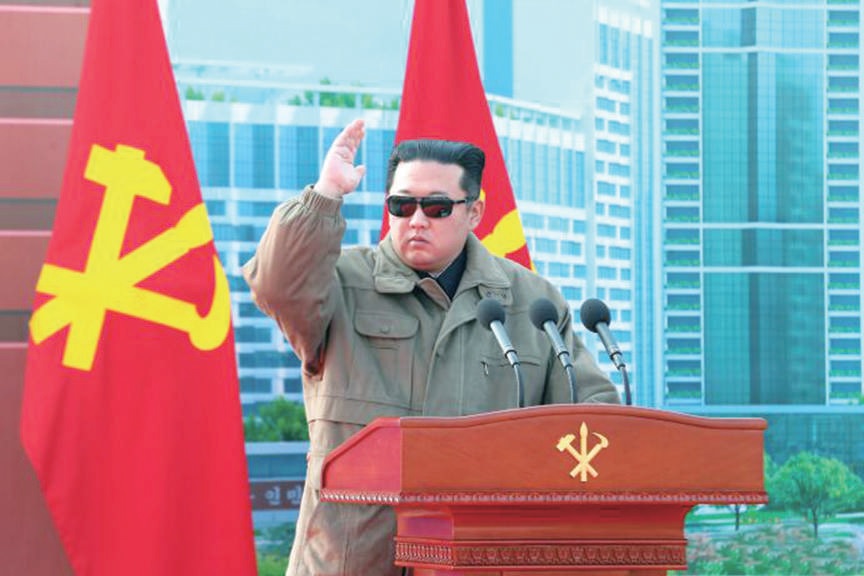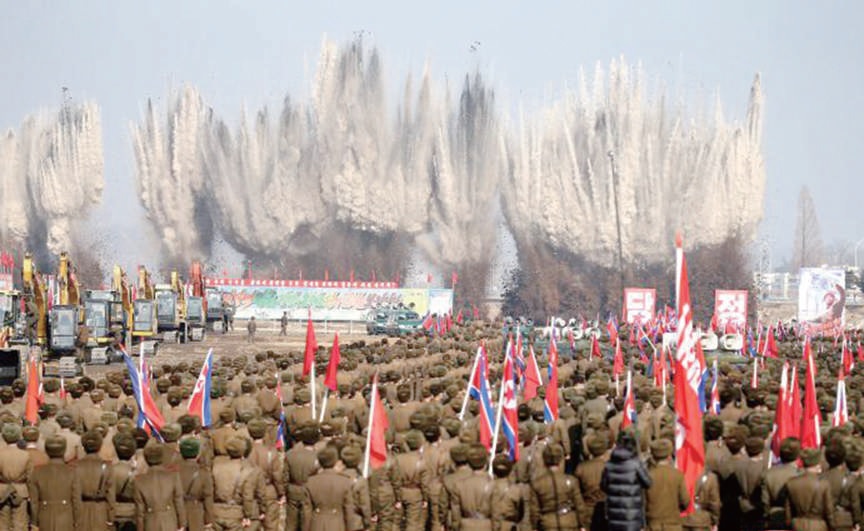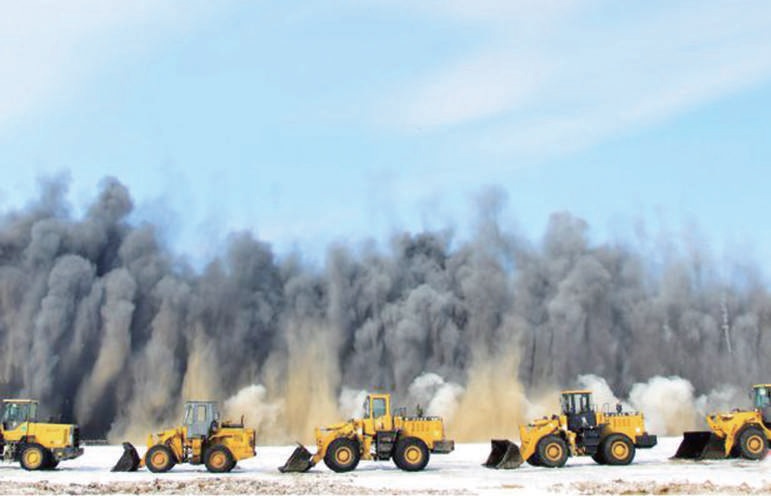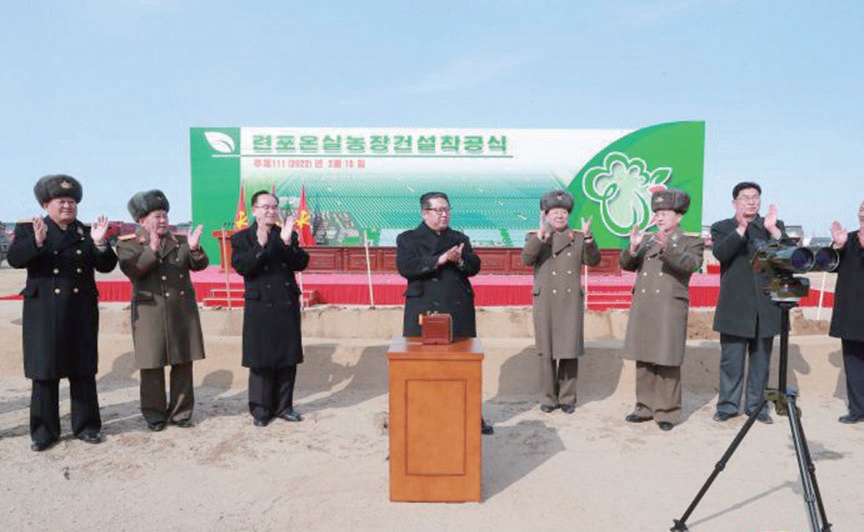火星區的激變及其意義
火星區的激變及其意義
Blasting in the Hwasong Area and Its Meaning

Thunderous explosion shook the Hwasong area in Pyongyang, the capital of the Democratic People’s Republic of Korea, on February 12, signifying the ground-breaking for the construction of another 10 000 apartment flats following the last year.
Promises to the People Are Fulfilled without Fail
Kim Jong Un, President of the State Affairs, attended the ground-breaking ceremony and made a speech. He attended in the ground-breaking ceremony for the project to build 10 000 flats in the Songsin and Songhwa area last year, too.
In fact, building houses in the Democratic People’s Republic of Korea means the expenditure of an enormous amount of money, materials and manpower, because houses are built at the state expense and provided to the people free of charge.
As he said in his speech, the project to build 10 000 flats in the Songsin and Songhwa area was carried out last year, despite the tough conditions where the country’s economic situation was harsh and difficulties were piling up.
This year, too, the sanctions and blockades by the hostile forces persist, and there is no prospect of the global health crisis being terminated. What, then, is the reason why the DPRK continues to invest a huge expenditure in housing construction under such situation?
The Eighth Congress of the ruling Workers’ Party of Korea held in early 2021 decided on building a total of 50 000 flats in the capital city alone during the five-year plan, i.e. 10 000 flats every year, while pushing ahead with housing construction across the country.
Kim Jong Un regards this decision for providing the people with excellent living conditions as a solemn promise of the WPK, the government and himself to the people. For this reason, he pushes ahead with the housing construction in spite of the piling difficulties.
For him, nothing is more solemn and important than fulfilling a promise to the people. Though he was busy with the overall affairs of the country, he attended the ground-breaking ceremony for building 10 000 flats every time and made a speech encouraging the builders. Last year, he led the project for building 10 000 flats in the Songsin and Songhwa area to be successfully completed by solving all the problems arising in the project although everything was in short supply.
What is worthy of note is the fact that he said in his speech that if the goal of building 50 000 flats in Pyongyang, which included the upcoming gigantic project in the Hwasong area, was attained with success, the Party would have fulfilled the most important promise it had made to the people, and the housing problem for the capital’s residents would have been fully solved. Then he stressed that that was why the WPK and the government were pushing ahead so forcefully with the construction of 10 000 flats in Pyongyang every year, even though the conditions and circumstances at present were more challenging than ever before.
The thunderous sound of blasting at the ground-breaking ceremony in the Hwasong area can be interpreted as a representation of his will that promises to the people must be fulfilled without fail.


Bringing Earlier the Spring of Prosperity
What drew attention in the ground-breaking ceremony was the flag of the headquarters for the construction of 50 000 flats in Pyongyang that fluttered beside the platform where Kim Jong Un stood. It was the one he had personally handed over to the persons related with the project for the building 10 000 flats in the Songsin and Songhwa area last year after declaring the start of the project.
According to his speech, the housing construction is not confined to construction itself.
Needless to say, it is accompanied by the work of developing the construction sector, including strengthening the sector’s material and technical foundations in a qualitative and quantitative way, realizing the diversification of building materials and their domestic production, increasing the proportion of mechanization of construction work, and applying advanced construction methods and architectural techniques on a wider scale. In other words, in the course of housing construction, the construction sector is modernized on a higher level and preparations are made for dealing with more larger and heavier projects.
The main point is that such progress will lead to large-scale construction of metallurgical and chemical industry bases, new power production bases and tidelands, and building projects for transforming the Komdok area, the Ryonpho area and all the rural areas of country. In short, the project in the Hwasong area is a source of the development of all the economic sectors including building-materials, machine-building, metallurgical, chemical and power industries and of the work to transform the country’s appearance.
The subjective and objective challenges and difficulties facing the DPRK today, including the sanctions and blockade by the hostile forces, are forcing only severe winter upon the people’s livelihood and economic development of the country. But Kim Jong Un put forward the construction sector in the vanguard of the effort to put an end to this winter and bring earlier the spring.
He is convinced that a fierce struggle for grand construction is under way, and in the course of it vacillation and lack of ability are being overcome, courage and wisdom displayed, backwardness and stagnation eliminated, progress and innovations achieved, and the power of the state and people to shape the future increased. Herein lies the reason why the flag is fluttering beside the platform where Kim Jong Un stands.
Kim Jong Un ensured that the new building project began in February, a month earlier than the start of the last year’s project. This is as good as a declaration of his determination before the world that he would resolutely blow up the challenges and difficulties and bring earlier the new spring of prosperity on the strength of self-reliance.


Source: Consulate General of the Democratic People’s Republic of Korea in Hong Kong
- Log in to post comments





